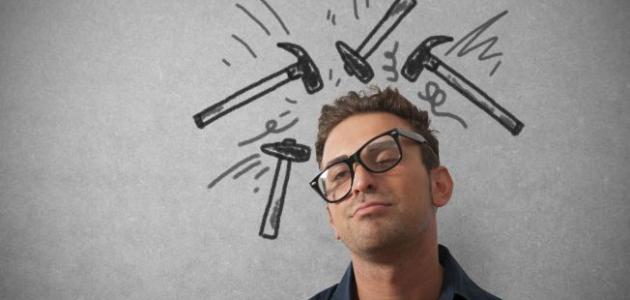Contents
Migraine
Migraine, migraine, or fissure disease is defined as a chronic neurological disorder that occurs in the form of seizures, and usually appears early in life or in middle age, and is accompanied by the emergence of a group of symptoms, including nausea, photophobia, in addition to headache On one side of the head, [1] [2] there are two main types of migraine, which are migraine headaches with aura called aura, which is a group of visual, sensory or verbal symptoms that accompany the headache attack or appear before it, and either The second type is known as non-aura migraine and it is the most common type, [3] [4]
To learn more about migraine, you can read the following article: ( What is migraine and its treatment ) .
It is worth noting that the main cause of migraine is still unknown, but it is believed that the genetic factor plays a role, as most of the sufferers have a family history of migraine, and it is more prevalent among women than men, and it usually affects people in the age group between 15 to 15 55 years, and it is good thing that the intensity of pain associated with migraine often decreases with age, and it is worth noting that there are a group of stimuli that may stimulate the emergence of migraine attacks in those with it, and the response to these stimuli varies from person to person, and from time to time, The patient responds to a certain type of stimuli once, and does not respond to them again, and we mention some of those stimuli that follow: lack or frequent sleep, exposure to bright and strong lights, smell strong odors, change hormones during the menstrual period in women, exposure to stress and stress, and drinking alcohol And eat foods that contain artificial flavors. [5]
To learn more about the causes of migraine, you can read the following article: ( Causes of migraine ) .
Migraine diagnosis
A person who suffers from regular headaches or any other symptoms indicative of migraine should see a doctor to confirm the diagnosis, as obtaining the correct diagnosis is important to start the appropriate treatment that relieves symptoms and helps prevent attacks from recurring. It is worth noting that there is no specific test to diagnose migraine, and usually the diagnosis needs to identify the pattern of recurrent headaches along with the associated symptoms, and what should be mentioned is that the symptoms of migraine They may be unexpected, and migraine attacks sometimes occur without the appearance of any other symptoms, so it may take some time to reach an accurate diagnosis. [6] [7]
Because there is no real test for the diagnosis of migraine, the doctor basically depends on the knowledge of the medical history of the person concerned and the exclusion of other causes of headaches, and usually includes sister diagnosed as follows: [6]
- A detailed history of the headache and other symptoms that the sufferer suffers from, and this history includes an analysis of the characteristics of the headache, which include the number of times the headache occurs, the severity of the pain, the symptoms that accompany it, its impact on daily activities, in addition to the need to know the family history of the headache.
- A comprehensive examination, including a complete neurological assessment, can help some techniques, such as: a CT scan or magnetic resonance imaging (Magnetic Resonance Imaging), an electroencephalogram (EEG) and an abbreviation EEG However, routine blood tests to rule out other causes of headaches are not used to directly diagnose migraine.
Diagnosis of migraine without aura
Migraine without aura affects 70-75% of patients with migraines, according to a report published by the American Migraine Foundation in 2019. This type is the most common type of migraine, [8] and a migraine without aura is usually diagnosed after observing at least five headache attacks, provided that each one meets the following criteria: [9]
- Headache attacks lasting 4-72 hours; Provided that the victim has never received treatment or that he received the wrong treatment.
- A headache has two or more of the following features:
- That the sufferer feel a headache on one side of the head.
- The headache is throbbing in nature.
- The severity of the headache ranges from moderate to severe.
- The severity of the headache increases due to the practice of routine physical activity, or the patient's abstention from his routine physical activities because of the pain resulting from the headache.
- The headache is associated with at least one of the following symptoms:
- Nausea
- Vomiting .
- Photophobia or phonophobia.
Diagnosis of migraine with aura
The percentage of people suffering from migraine with aura is 25-30%, according to a report published in the American Migraine Foundation in 2017, and aura includes many disorders such as seeing shapes, bright spots, or flashes of light, or lack of vision, and a sense of tingling Caldbabis in the arm or leg, in addition to the feeling of weakness or numbness on one side of the body or face, hear the sounds disturbing, moving gestures vibratory can not be controlled, [10] [2] and is diagnosed Migraine with aura if a person suffers from at least two attacks of headache that meet the following criteria: [11]
- The headache is associated with one or more of the symptoms of a fully reversible aura, which are visual, sensory, speech or language-related symptoms, or symptoms related to movement, the base of the brain, or the retina.
- A headache has at least three of the following six characteristics:
- The appearance of at least one of the symptoms of aura that lasts for five minutes or more.
- Two or more symptoms of aura appear in sequence.
- Each symptom of aura continues for a period ranging from 5-60 minutes.
- Feeling at least one of the symptoms of aura on only one side of the body.
- A tingling sensation that resembles needle sticks, this is known as symptoms of a positive aura.
- Suffering from headache in conjunction with or after the onset of aura symptoms within 60 minutes.
Diagnosis of chronic migraine
According to a report published in the American Migraine Foundation in 2016, the percentage of people who suffer from chronic migraine headaches is about 1%, and chronic migraine can be diagnosed by observing the previously mentioned symptoms when talking about migraine Accompanied by an aura or not accompanied by aura, and the diagnosis of chronic migraine may be possible in the event of suffering from migraine symptoms for at least eight days in one month and for at least three months, or in some cases it may require the appearance of symptoms for at least 15 days And for a period of more than three months, depending on the patient's condition and according to what the doctor deems appropriate. [12] [11]
Differential diagnosis of migraine
Accurate diagnosis of migraine requires the necessity to distinguish between the symptoms of the different types of headache and the symptoms of migraine, as migraine headaches are characterized by that they last for long periods ranging from hours to days, and in general the period of absence of symptoms of the disease is more than the period of their appearance, and the rate of its attacks reaches Once a month, [13] As for other types of headache, its explanation and accompanying symptoms come in some detail below: [14] [15]
- Tension headache: , this type of headache is the most common, and its symptoms appear on both sides of the head and not on one side, as is the case in migraine, and it causes a feeling of pressure or tension in the head without causing a feeling of pulse, and the symptoms of Its episodes range from half an hour to seven days, and it is worth noting that the pain associated with a tension headache does not get worse with the practice of daily activities, such as: bending or climbing stairs, and its intensity ranges from moderate to light, so it does not hinder the performance of normal daily activities, and from It is worth noting that this type of headache is not accompanied by phobia of light, sound, vomiting, or nausea, and it does not affect the person for more than 15 days per month.
- Headache Rebound: This affects the type of headaches on both sides of the head, and worsened exercise physical activities and mental stress daily, and is characterized by this kind to happen on a daily basis , or almost daily, and the patient may Astakiz suffering from headaches as well as nausea, forgetfulness, Feeling discomfort, and stopping some types of medications, such as ergot derivatives, barbiturate and codeine, may be the underlying cause of rebound headache.
- Cluster headaches: is characterized by this type of headache feeling severe pain in one side of the head and described the patient as a burning pain or similar stabbing knife, stationed in the eye socket and around, and is accompanied by this type of headache and one of the following symptoms at least Facial sweating, tears, narrowing of the pupils, nasal congestion , drooping eyelids, and runny nose, and the duration of the infection ranges between 15 minutes to three hours, and it was called a cluster headache because it occurred several times during the day between one to eight times a day during a period Headaches that may last from two weeks to three months, and it is worth noting that the symptoms of cluster headaches may disappear for several months or years before the attack recurs again.
- Constant headaches daily new: and Acronym NDPH, show symptoms of this type of headache on both sides of the head, and suddenly, and does not respond to many types of medicines, it is worth mentioning that this type of headache is not associated with other diseases.
- Sinus headache: is characterized by symptoms of this type of headache to feel a deep and constant pain in the bones of the cheek, or forehead, or nose, and more acute pain usually with sudden head movement or stress, and accompanies this type of headache symptoms of sinus acute Others, such as: runny nose, unpleasant taste in the mouth, congestion in the ears, swelling of the face, and fever .
- Headache , excessive intake of medicine: This type of headache as a result of excessive use of painkillers occur available that do not need a prescription or painkillers prescribed, such as opioids, sedative and sleeping pills to treat headaches.
Recording daily notes related to headaches helps the doctor to diagnose more accurately, and also helps the patient to identify the factors that stimulate and cause migraine, in addition to the warning signs that precede the headache, and evaluate the effectiveness of the drug in controlling the headache, and examples of observations that should be noted : When symptoms appear, how often they occur, where the pain is felt, and what type of pain is; Such as pain accompanied by palpitations, and other symptoms associated with headache such as the occurrence of vision problems, the duration of the headache attack, the medicines that were used to treat the headache, and the effectiveness of the treatment, in addition to that, other notes should be noted. Such as the time of eating, the types of food you eat, the medicines that the patient takes to treat other conditions, and vitaminsOr nutritional supplements, the number of sleep hours, the exercise performed, social and work activities, and other factors, such as: weather factors, and the details of the menstrual cycle for women. [16] [7]
Cases that require medical intervention
People who suffer from headaches are advised on a regular basis to record when the headaches occurred and how they were treated, as we have previously explained, and anyone suffering from headaches is advised to consult a doctor in the event that the pattern of headaches changes or if any of the following appears: [17] [18]
- Feeling a sudden, severe headache, unlike any headache you've had before.
- Migraine frequent more than five days a month, even if it can be controlled with medication.
- Suffering from headaches after reaching the age of fifty.
- Having a headache after a head injury, especially if the headache gets worse after the injury.
- Headache worsens after coughing, straining or sudden movement.
- Feeling of weakness or paralysis on one side of the face, or in one arm, or both arms.
- Have a headache with a fever, stiff neck, mental confusion, convulsions, double vision, weakness, numbness, or difficulty speaking.
References
- ↑ "Migraine headache in adults" , bestpractice.bmj.com , Retrieved 29-11-2019. Edited.
- ^ A b "Migraine" , Www.mayoclinic.org , Retrieved 29-11-2019. Edited.
- ↑ "Migraine" , ichd-3.org , Retrieved 29-11-2019. Edited.
- ↑ "Migraine Headaches Without Aura" , www.webmd.com , Retrieved 18-12-2019. Edited.
- ↑ "Migraine" , www.womenshealth.gov , Retrieved 29-11-2019. Edited.
- ^ A b "Diagnosis" , Www.migrainetrust.org , Retrieved 29-11-2019. Edited.
- ^ A b "Diagnosis -Migraine" , Www.nhs.uk , Retrieved 19-12-2019. Edited.
- ↑ "Migraine Without Aura" , americanmigrainefoundation.org , Retrieved 30-11-2019. Edited.
- ↑ "Migraine without aura" , ichd-3.org , Retrieved 30-11-2019. Edited.
- ↑ "Understanding Migraine with Aura" , americanmigrainefoundation.org , Retrieved 11-30-2019. Edited.
- ^ A b Jes Olesen, Timothy J Steiner, David Dodick (2017), The International Classification of Headache Disorders , Page 11. Edited.
- ↑ "Chronic Migraine" , americanmigrainefoundation.org , Retrieved 18-12-2019. Edited.
- ↑ “MIGRAINE: DIAGNOSIS AND MANAGEMENT” , nnp.bmj.com , Retrieved 4-12-2019. Edited.
- ↑ "Headaches in Adults" , my.clevelandclinic.org , Retrieved 4-12-2019. Edited.
- ↑ "Differential Diagnosis of Migraine" , www.medscape.org , Retrieved 19-12-2019. Edited.
- ↑ "Keeping a migraine diary" , www.migrainetrust.org , Retrieved 11-30-2019. Edited.
- ↑ "Migraine" , www.mayoclinic.org , Retrieved 30-11-2019. Edited.
- ↑ "Migraine" , www.nhs.uk , Retrieved 30-11-2009. Edited.




